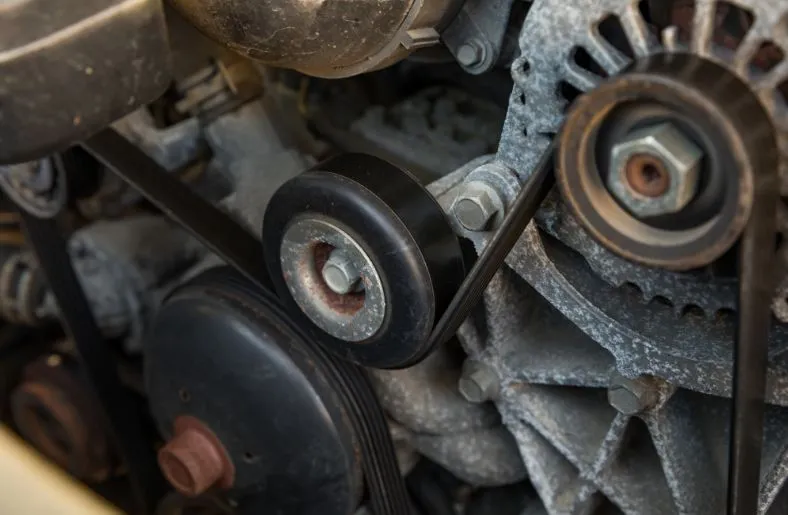Idler pulleys play a crucial role in the smooth operation of a vehicle’s engine. These small but mighty components are responsible for maintaining tension in the serpentine belt, ensuring that power is efficiently transferred to the various engine accessories. However, over time, idler pulleys can develop a squeaking noise, indicating potential wear or damage.
In this comprehensive guide, I will walk you through the step-by-step process of how to fix a squeaky idler pulley like a pro.
Table of Contents
Signs of a Squeaky Idler Pulley and why it’s important to Fix It
Before we dive into the repair process, let’s first understand the signs that indicate a squeaky idler pulley. The most obvious sign is a high-pitched squeaking or chirping noise coming from the engine area. This noise is most noticeable when the engine is running and can become increasingly louder over time.
Ignoring a squeaky idler pulley can lead to serious consequences, such as premature wear on the serpentine belt, decreased engine performance, and even a complete failure of the belt system. It’s crucial to address this issue promptly to prevent further damage and ensure the longevity of your vehicle.
Safety Precautions Before Starting the Repair Process
Before we get our hands dirty, it’s important to prioritize safety. Here are some essential safety precautions to take before starting the process of how to fix a squeaky idler pulley:
- Park your vehicle in a safe and well-ventilated area: Ensure that you have enough space to maneuver around the engine and that the area is well-lit and properly ventilated to prevent any accidents.
- Disconnect the battery: To avoid any electrical mishaps, disconnect the negative terminal of the battery to cut off the power supply to the engine.
- Allow the engine to cool down: Working on a hot engine can be dangerous. Wait for the engine to cool down completely before starting the repair process.
- Wear appropriate safety gear: Protect yourself by wearing safety goggles, gloves, and clothing that covers your arms and legs.
Now that we’ve covered the safety precautions, let’s move on to the step-by-step process of fixing a squeaky idler pulley.
How to Fix a Squeaky Idler Pulley: A Step-by-Step Guide
Step 1: Gathering the Necessary Tools and Materials
To fix a squeaky idler pulley, you’ll need a few tools and materials. Here’s a list of what you’ll need:
- Socket wrench set: A socket wrench set will be required to remove the bolts securing the serpentine belt and the idler pulley.
- Replacement idler pulley: If your idler pulley is beyond repair, it’s advisable to have a replacement on hand before you begin the repair process.
- Serpentine belt diagram: This diagram will help you correctly route the serpentine belt after the repair.
- Cleaning solvent: A cleaning solvent will be needed to remove any debris or dirt from the idler pulley.
- Lubricant: A high-quality lubricant specifically designed for automotive use will be necessary to reduce friction and eliminate the squeaking noise.
Now that you have all the necessary tools and materials, let’s move on to the next step.
Step 2: Locating the Squeaky Idler Pulley
The idler pulley is typically located near the front of the engine, close to the alternator and other accessories driven by the serpentine belt. Consult your vehicle’s manual or a trusted online resource to accurately locate the idler pulley. Once you’ve identified its position, you’re ready to move on to the next step.
Step 3: Removing the Serpentine Belt
Before you can access the idler pulley, you’ll need to remove the serpentine belt. Begin by locating the belt tensioner, which is responsible for keeping the serpentine belt tight. Using a socket wrench, rotate the tensioner counterclockwise to release tension on the belt.
With the tension released, carefully slide the belt off the idler pulley and other accessories. Take note of the belt routing or refer to the serpentine belt diagram to ensure proper reinstallation later.
Step 4: Inspecting the Idler Pulley for Damage or Wear
With the serpentine belt removed, it’s time to inspect the idler pulley for any signs of damage or wear. Look for cracks, chips, or any abnormal wear patterns on the surface of the pulley.
Additionally, spin the pulley by hand to check for smooth rotation. If you notice any significant damage or if the pulley does not spin freely, it’s advisable to replace the idler pulley entirely.
Step 5: Lubricating the Idler Pulley
If the idler pulley appears to be in good condition, the next step is to lubricate it. Apply a small amount of lubricant to the bearing or bushing of the idler pulley.
Be careful not to over-lubricate, as excessive lubrication can attract dirt and debris, causing further damage. Once the lubricant is applied, rotate the pulley by hand to ensure even distribution.
Step 6: Reinstalling the Serpentine Belt
Now that the idler pulley has been inspected and lubricated, it’s time to reinstall the serpentine belt. Refer to the serpentine belt diagram or the notes you made during the removal process to ensure proper routing. Begin by sliding the belt over the idler pulley, making sure it fits into the grooves of all the other accessories.
Once the belt is properly aligned, rotate the belt tensioner counterclockwise again to create enough slack to slide the belt onto the tensioner pulley. Release the tensioner slowly, allowing it to apply tension to the belt.
Step 7: Testing the Repaired Idler Pulley
With the serpentine belt reinstalled, start the engine and listen for any squeaking or chirping noises. If the idler pulley has been successfully repaired, the noise should be eliminated, and the engine should run smoothly.
Take the vehicle for a short test drive to ensure there are no further issues with the idler pulley.
Related Guide: How to Fix Squeaky Motorcycle Brakes (2024)? Explained!
FAQs
1. Why is my idler pulley squealing?
One of the common bad idler pulley symptoms is when the engine belts start producing a squealing sound. When the pulley seizes, or the surface is worn out, then there is a squealing noise as the engine belt rubs against its surface, due to the absence of enough motion from the pulley, a squealing sound is produced.
2. Can I drive with a noisy idler pulley?
You can continue to drive with a bad idler pulley until it fails. However, we wouldn’t recommend it, as a failing idler pulley could cause the drive belt to slip or snap off, bringing critical engine accessories like the alternator and power steering pump to a halt.
3. How do you clean an idler pulley?
A stiff wire brush, a small flat-blade screwdriver, or sometimes even a pick may be used. Again working with the engine off, rotate the affected pulley by hand to make sure its entire running surface is clean. Flat-sided roller pulleys can be cleaned easily with light sanding to remove accumulated fragments.
Conclusion
Fixing a squeaky idler pulley is a task that can be easily accomplished with the right tools, materials, and knowledge. By following the step-by-step guide on how to fix a squeaky idler pulley, you can address this common issue and ensure the smooth operation of your vehicle’s engine. Remember to prioritize safety, thoroughly inspect the idler pulley, and use the correct lubricant to eliminate the squeaking noise.
Additionally, regular vehicle maintenance, including inspecting the serpentine belt and keeping the engine area clean, is crucial for the long-term health of your idler pulleys and overall engine performance. By taking proper care of your vehicle, you can enjoy a quieter and more reliable driving experience. Remember, it’s always recommended to consult a professional mechanic if you are unsure or uncomfortable performing any repairs on your vehicle.

